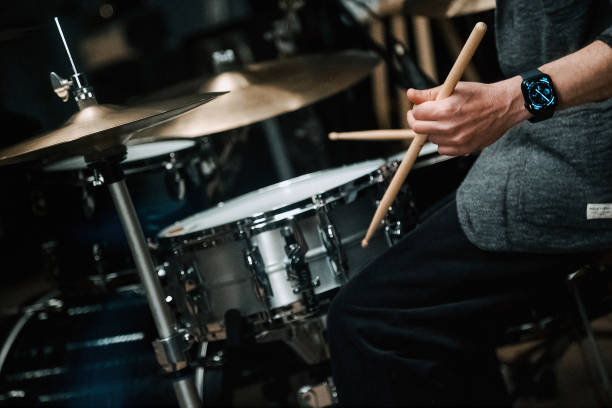Drumming is a physically demanding art that requires endurance, precision, and control. Whether performing on stage, practicing for hours, or recording in a studio, drummers put immense strain on their hands, wrists, shoulders, and legs. To maintain peak performance and longevity in their careers, professional drummers adopt effective strategies to prevent and recover from injuries. This guide explores practical techniques on how Drummers Prevent & Recover from Injuries.

The Physical Demands of Drumming
Drumming engages the entire body, requiring strength, coordination, and flexibility. The repetitive nature of drumming can lead to strain, making injury prevention essential. Common problem areas include:
- Wrists and Hands: Frequent striking can lead to strain or tightness.
- Shoulders and Arms: Long sessions can cause fatigue or stiffness.
- Back and Posture Issues: Poor posture leads to tension and pain.
- Legs and Ankles: Bass drum and hi-hat techniques can result in overuse injuries.
Understanding the physical impact of drumming helps drummers take proactive steps toward injury prevention.
Preventing Injuries: Best Practices for Drummers
1. Warm-Up Before Playing
Just like athletes stretch before a workout, drummers should warm up before playing. Warming up helps increase blood flow, loosen muscles, and prepare the body for movement.
- Hand and wrist exercises: Stretch fingers, rotate wrists, and shake hands lightly.
- Arm and shoulder stretches: Rotate shoulders and gently stretch arms to improve flexibility.
- Leg and ankle mobility drills: Stretch calves, rotate ankles, and practice light footwork before playing.
2. Maintain Proper Posture
Posture plays a crucial role in preventing drumming-related injuries. A well-balanced, comfortable position reduces unnecessary strain.
- Sit with a straight back: Avoid slouching to reduce stress on the lower back.
- Adjust drum height: Set up drums so that they allow comfortable arm and leg movement.
- Position pedals correctly: Avoid excessive reach or awkward angles that may cause discomfort.
3. Use the Right Drumming Technique
Incorrect technique is a leading cause of strain and injury. Drummers should focus on:
- Relaxed grip: Avoid gripping drumsticks too tightly. A loose grip reduces tension and increases fluidity.
- Controlled stick motion: Let the drumstick rebound naturally to minimize impact stress.
- Balanced foot technique: Avoid excessive pressure on the bass pedal; use natural movement instead.
4. Strength and Flexibility Training
Building strength and flexibility improves endurance and reduces the risk of injury.
- Hand and wrist exercises: Squeeze a stress ball, use hand grips, or perform light resistance training.
- Core workouts: Strengthen abdominal and lower back muscles to support posture.
- Stretching routines: Regular stretching keeps muscles loose and prevents stiffness.
5. Take Breaks and Listen to Your Body
Overplaying can lead to fatigue and injuries. Drummers should:
- Schedule breaks: Take short breaks every 30–45 minutes to rest muscles.
- Rotate practice sessions: Alternate between fast and slow drumming to prevent repetitive strain.
- Recognize discomfort: Stop playing if pain occurs and avoid pushing through injuries.
6. Stay Hydrated and Maintain a Healthy Diet
Proper hydration and nutrition support muscle recovery and overall endurance.
- Drink enough water: Hydration keeps joints lubricated and prevents cramps.
- Eat balanced meals: A diet rich in protein, healthy fats, and carbohydrates fuels muscle recovery.
- Avoid excessive caffeine or alcohol: These can dehydrate the body and contribute to muscle tightness.
Recovering from Drumming Injuries
Even with the best prevention strategies, injuries can still happen. Recovery is crucial for long-term drumming success. We can look further into How Drummers Prevent & Recover from Injuries.
1. Rest and Reduce Playing Time
If pain or discomfort occurs, take time off to allow muscles and tendons to heal. Playing through pain can lead to more severe injuries.
- Limit drumming intensity: Reduce practice hours or switch to lighter techniques.
- Use alternate drumming methods: Try electronic drums or practice pads to reduce impact.
- Engage in other musical activities: Work on composition, theory, or listening exercises while recovering.
2. Ice, Heat, and Massage Therapy
Applying ice or heat can speed up recovery and ease muscle tension.
- Ice packs: Use ice on sore areas to reduce swelling and inflammation.
- Heat therapy: Apply heat packs or take warm baths to relax tight muscles.
- Massage techniques: Gentle massage can relieve muscle tension and improve circulation.
3. Strengthen Weak Areas Gradually
Once recovered, gradually reintroduce playing to avoid re-injury.
- Start slow: Play lightly and increase intensity over time.
- Use resistance bands: Strengthen muscles with controlled resistance exercises.
- Incorporate mobility drills: Improve flexibility before resuming full-speed drumming.
4. Seek Professional Guidance
If pain persists, consulting a specialist such as a physical therapist or music-focused trainer can provide targeted advice.
- Ergonomic assessment: A professional can analyze drumming posture and recommend adjustments.
- Custom exercises: Targeted rehabilitation exercises can speed up recovery.
Long-Term Drumming Health: Building a Sustainable Routine
Professional drummers must adopt lifelong habits to ensure longevity in their careers.
- Invest in ergonomic drum gear: Choose drum thrones, pedals, and sticks that reduce strain.
- Practice mindfulness and breathing exercises: Reduce tension and stay relaxed while playing.
- Continue learning about body mechanics: Stay informed about best practices in drumming health.
FAQs About Injury Prevention and Recovery for Drummers
1. How can drummers avoid wrist and hand injuries?
Drummers can prevent wrist and hand injuries by using a relaxed grip, maintaining proper technique, warming up before playing, and taking regular breaks.
2. What is the best way to recover from drumming-related soreness?
Rest, ice or heat therapy, gentle stretching, and gradual reintroduction to playing help recover from soreness and minor injuries.
3. How long should drummers take a break if they experience pain?
The duration of rest depends on the severity of the discomfort. Minor soreness may require a day or two of rest, while more persistent pain may need a longer break and professional guidance.
4. Can drumming injuries be completely avoided?
While injuries cannot always be completely avoided, following proper techniques, warming up, strengthening muscles, and listening to one’s body can significantly reduce the risk.
Drumming is a physically demanding art that requires careful attention to technique, endurance, and injury prevention. By incorporating warm-ups, maintaining good posture, strengthening key muscles, and taking necessary breaks, professional drummers can keep injuries at bay and enjoy long, fulfilling careers. In cases of discomfort or strain, rest and proper recovery techniques are essential for returning to drumming in top form. With the right strategies in place, drummers can continue to perform at their best while protecting their most valuable instrument—their body.
